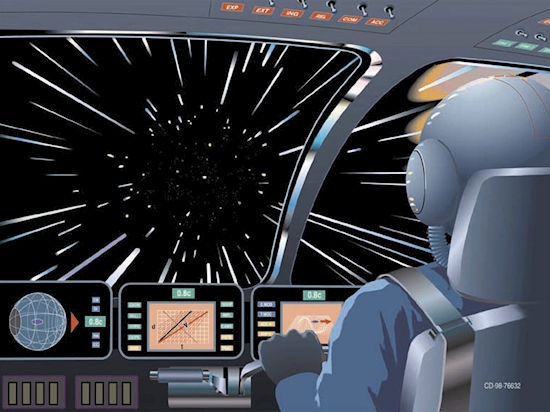Is "Warp Drive" From Star Trek Possible?
One of the key plot devices in nearly every Star Trek episode and film is the ability of star ships to travel at light-speed and beyond. This happens thanks to a propulsion system known as warp drive. It sounds "science-fictiony" and it is, although, in theory, some version of a propulsion system could be created from the idea, given enough time, money, and materials. So, there's hope for a future of FTL travel, but not a lot of evidence that it will happen soon.
Warp drive doesn't actually exist yet. But, it's theoretically possible. It allows the science fiction ships to get across space by moving faster than the speed of light. That's an important aspect since lightspeed is the ultimate cosmic traffic law.
This is because, as far as we know, nothing can move faster than light. According to Einstein's theories on relativity, it takes an infinite amount of energy to accelerate an object with mass up to the speed of light. So, it would appear that having a spacecraft traveling at (or exceeding) the speed of light is strictly impossible. But, there doesn't seem to be a prohibition on traveling as close as possible to light-speed. And, warp drive actually postulates a way around the speed limit of light.
However, our current understanding of the physics of how light travels does not preclude the possibility of space itself traveling at or beyond the speed of light. In fact, some people who have examined the problem claim that in the early universe, space-time expanded faster than the speed of light, if only for a very short interval. If that's true, a warp drive could take advantage of this loophole. It would use massive amounts of energy extracted from matter-antimatter annihilations in the "warp core" of the ship to encapsulate the starship in a bubble that "warps" the area around it. Space-time behind the vessel is expanded, while the space-time continuum is compressed in front. The net result is that the ship is pushed along as space-time expands and contracts around it.
Here's another way to think about how the warp drive works: the starship is effectively stationary relative to a local area of space-time. The ship itself isn't moving, but the fabric of the universeis moving and that carries the starship along with it. A happy byproduct of this is that the starship can get around such undesirable effects as time dilation and massive acceleration effects on the human body, which would really mess up the science fiction storylines.
Using warp drive would be different from traveling across the universe using wormholes. These are theoretical structures that allow spaceships to travel from one point to another by tunneling through hyperspace. Effectively, they would let ships take a shortcut since they remain bound to normal space-time.
There is nothing in our current understanding of theoretical physics that prohibits a warp-type drive from being developed. However, it the whole idea is still in the realm of speculation. It's also not possible with current technology. People ARE working on ways to achieve such a development, but they have to solve a LOT of issues to make it happen.
In order to create and sustain a warp bubble (which is a challenge if the captain doesn't want to destroy the ship when the drive is deployed), a theoretical type of matter would have to exist with negative mass. No one even knows if negative mass (or negative energy) exists anywhere in the universe. If they do, they haven't been "found", yet. So, that's a pretty significant hurdle: finding something similar to "unobtainium" to solve a problem that is otherwise impossible to fix without it. But, let's suppose that this stuff exists. Then, one could devise a warp drive system.
In fact, at least one such design has garnered attention: the Alcubierre drive. In that iteration of the warp drive, the starship rides a "wave" of space-time, much like a surfer rides a wave on the ocean. The ship gets from one place to another and exploration of the galaxy ensues.
However, just because a drive system could be theoretically possible, does not mean that it is possible. The sheer amount of energy required to create the necessary expansion and contraction of space-time would exceed the output of the Sun.
Even with a power source as potent as the one described in the Star Trek series, having a warp drive is a long way off. At the very least, we don't have an evolved enough understanding about the physical nature and composition of the universe to really evaluate what is possible in the realm of faster-than-light-travel. It will take time and a lot of research to move forward to the point where humans could develop warp drive. Until then, people will have to enjoy seeing it deployed in science fiction movies and TV shows.
Edited by Carolyn Collins Petersen.
Source: www.thoughtco.com

